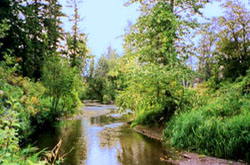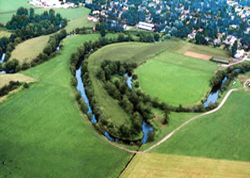Riparian areas
All habitats within the agricultural landscape are important, but aquatic and riparian areas are especially significant to both biodiversity and agricultural production.
Aquatic areas are considered to be some of the most productive ecosystems on Earth. Collectively, rivers, streams, lakes, and wetlands provide habitat for at least 25% of B.C.’s vertebrate, invertebrate, and vascular plant species.
Aquatic ecosystems interact closely with riparian areas—the zones of lush, green, moisture-loving vegetation that surround wetlands, lakes, streams, and rivers. Riparian areas form a transition zone between aquatic and dry, upland habitats.
Common to all riparian areas are the following :
- A combined presence and abundance of water, either on or close to the surface
- Vegetation that responds, requires and survives well with abundant water
- Soils that are modified by abundant water, stream or wetland processes and lush, productive and diverse vegetation
Riparian functions
A healthy riparian area will demonstrate some of the following key ecological functions:
- Builds and maintains stream banks
- Stores floodwater and reduces stream flow energy
- Recharges groundwater
- Traps sediments
- Filters nutrients from water
- Maintains and enhances biodiversity
- Supports primary production
- Sequesters carbon
- Shades the stream to reduce solar heat gain
Management of riparian areas
Key components to management of riparian areas are directly linked to maintaining good soil and water conservation practices across the landscape and preserving, as much as possible, the integrity of the natural riparian zone.
Improvement of riparian areas
Improvement of agricultural riparian areas can occur by implementing a number of practices.
Riparian Area Resources
Valuable information on riparian areas is available from many other agencies and organizations.


Contact information
AgriService BC
Have a question? Call or email and a staff person will assist you.
Telephone: 1 888 221-7141
E-mail: AgriServiceBC@gov.bc.ca
